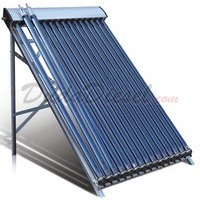skyking1
New Member
We are building a new home in the Olympic rain shadow, where the sun shines more and it rains less than anywhere around it.
It has a less than ideal roof pitch for flat collectors at 3:12, but this is a better pitch for my personal safety
I am using standing seam metal so I can employ the clips ffrom S5! or similar and avoid roof penetrations.
The current idea is to have a mixed system of a modest PV array of ~5Kw, and a large vac tube array that will feed an insulated soil/sand thermal mass through the hot season.
The hydronic system works with a maximum of 40C input temps, and I am working to size the array and storage to drive it up to 65C for a delta T of 25C.
Initially I had thought of a ~140,000 Kg mass, but now I am leaning to a smaller mass to ensure I get to the higher temperatures I seek. I will put in the infrastructure for a second mass so I can look at first year data and make adustments.
Since this is a new home build, I will have chases built in to the ridge cap and conduit installed and pre-inspected for solar panel installations on both south facing roofs.
I will have about 5 tons of GSHP loops in the ground, and was going to do a water to water Ground Source Heat Pump(GSHP) for the planned hydronics, as well as a 3 ton water to air GSHP for our brief air conditioning season and to provide for quick reaction heating. That heat pump is large enough to heat the whole house all year, but we want warm floors.
With this heat mass idea and collectors, I would omit the water to water 3 ton heat pump entirely. If it was all for naught, I can install it and take that credit next season.
With the relatively low costs of PV panels, I may be barking up the wrong tree, but I want to do the mental exercise before I dismiss it entirely.
Has anyone looked into this idea lately?
It has a less than ideal roof pitch for flat collectors at 3:12, but this is a better pitch for my personal safety
I am using standing seam metal so I can employ the clips ffrom S5! or similar and avoid roof penetrations.
The current idea is to have a mixed system of a modest PV array of ~5Kw, and a large vac tube array that will feed an insulated soil/sand thermal mass through the hot season.
The hydronic system works with a maximum of 40C input temps, and I am working to size the array and storage to drive it up to 65C for a delta T of 25C.
Initially I had thought of a ~140,000 Kg mass, but now I am leaning to a smaller mass to ensure I get to the higher temperatures I seek. I will put in the infrastructure for a second mass so I can look at first year data and make adustments.
Since this is a new home build, I will have chases built in to the ridge cap and conduit installed and pre-inspected for solar panel installations on both south facing roofs.
I will have about 5 tons of GSHP loops in the ground, and was going to do a water to water Ground Source Heat Pump(GSHP) for the planned hydronics, as well as a 3 ton water to air GSHP for our brief air conditioning season and to provide for quick reaction heating. That heat pump is large enough to heat the whole house all year, but we want warm floors.
With this heat mass idea and collectors, I would omit the water to water 3 ton heat pump entirely. If it was all for naught, I can install it and take that credit next season.
With the relatively low costs of PV panels, I may be barking up the wrong tree, but I want to do the mental exercise before I dismiss it entirely.
Has anyone looked into this idea lately?




